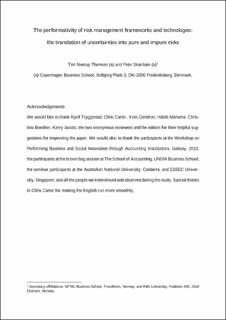The performativity of risk management frameworks and technologies: The translation of uncertainties into pure and impure risks
Peer reviewed, Journal article
Accepted version
Permanent lenke
https://hdl.handle.net/11250/2678217Utgivelsesdato
2018Metadata
Vis full innførselSamlinger
Originalversjon
10.1016/j.aos.2018.01.001Sammendrag
This article examines the long-term dynamics among a best-practice risk management framework, risk management technologies and the translation of uncertainties into risks by using a longitudinal case study of a large mega-project. We show that the framework and technologies through the visual power of inscriptions and the purifying work of risk consultants as experts establish the boundaries of the forms of uncertainties that are accepted and included as risks. We term the accepted and included risks ‘pure risks’ and the risks excluded after disagreement ‘impure risks’. We also show that the construction of impure risks challenges the predictions of the framework causing a false sense of security for the project objectives, and that the continuous readjustment of technologies, in particular, is necessary to ensure the long-term realisation of these predictions. Finally, this article contributes to the literature on performativity by showing how technologies serve as buffers to shield failing economic frameworks against criticism.

